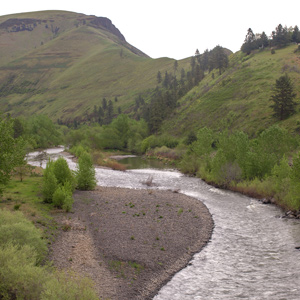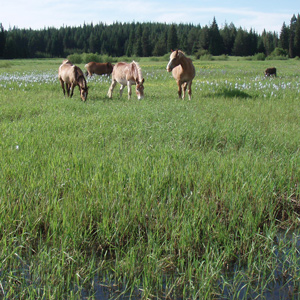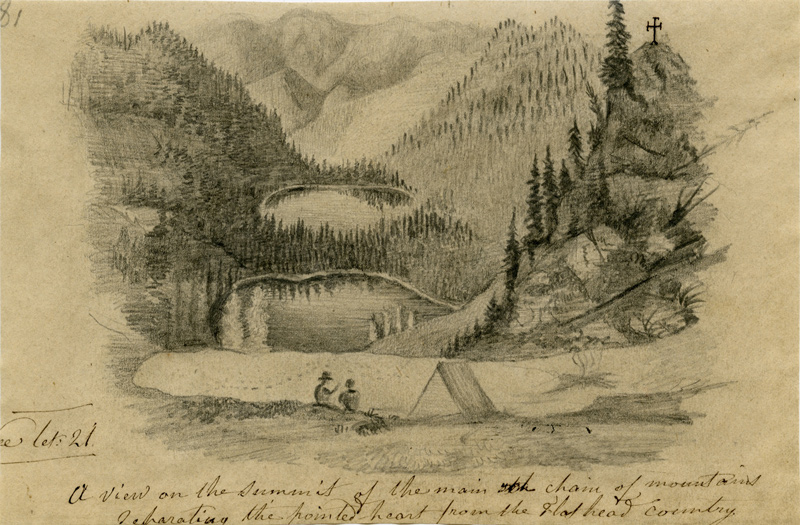Bitterroot Summit View
Drawing by Nicolas Point (c. 1841–47)[1]Nicolas Point, 1799-1868, “A View on the Summit,” Jesuit Archives Digital Collections and Resources, accessed September 25, 2021, https://jesuitarchives.omeka.net/items/show/140.
Nicolas Point was an untrained artist and Catholic missionary with the Flatheads and Pend d’Oreilles at St. Mary’s Mission and the Coeur d’Alenes at the Mission of the Sacred Heart. He is often called Father De Smet‘s artist. The drawing accurately represents the Bitterroot Mountains crossed by the Lewis and Clark Expedition in 1805 and 1806. Point often added religious symbols in his drawings such as the cross on the height above the encampment.
The writing at the bottom of the drawing says:
A view on the summit of the main chain of mountains separating the pointed heart from the Flathead country.
‘Pointed heart’ is one of the English interpretations of the French ‘Coeur d’Alene’.
The French appellation Coeur d’Alene literally translates ‘heart of an awl’ but its history and meaning remain speculative when applied to the indigenous nation. The people called themselves, Skitswish (Schitsu’umsh). This may have referred to a single band, a village site, or perhaps meant ‘the discovered people.’ Historical spellings include “Skeetsomish, Skitswish, Skeetshoo, Skeetshues, Sketsui, Sketch Hue, Sketch Hughe, Skitsuish, Schizuumsh, Skee-cha-way, Skeelsomish, Skeetsonish, Sketsomish, Skit-mish, Skitsaih, Skitsaish, Skitsamuq, Skítsui, Skítwish, Skitawish, Stchitsui, Stiel Shoi, and Stietshoi.”[2]Gary Palmer, Handbook of North American Indians: Plateau Vol. 12, ed. Deward E. Walker, Jr. (Washington, D.C.: Smithsonian Institution, 1998), 325; Robert H. Ruby, John A. Brown, and Cary C. Collins, … Continue reading
The Skitswish traditionally lived along rivers and streams flowing into and from today’s Lake Coeur d’Alene. The present-day Coeur d’Alene Tribe recently regained possession of the southern third of their namesake lake. Some streams on which they resided and hunted were tributary to the Clearwater River, and interaction—mostly peaceful—with the Nez Perces flowed along those riverine courses. Such an occurrence happened on 6 May 1806, when Lewis and Clark met three Coeur d’Alene men at the mouth of the Potlatch River, named Colter’s Creek in the journals.
Lewis noted the people’s culture was much the same as the Nez Perces, but that their language was entirely different. They told him of a large lake receiving a river with a falls a short distance below the lake. The geographical information received was interpreted by the captains to be Clarks Fork, Lake Pend d’Oreille, and Kettle Falls on the Columbia. The three Skitswish men may have been describing their home area, the St. Joseph and Coeur d’Alene rivers, Coeur d’Alene Lake, and Spokane Falls.
Related Pages
May 6, 1806
Three Coeur d'Alenes


The expedition spends most of the day at the Potlatch River—their Colter’s Creek. Lewis meets three Coeur d’Alene Indians, and Clark gives medical aid. They eventually move to another Nez Perce village.
June 23, 1806
Three Nez Perce guides


While waiting at Weippe Prairie for mountain snow to melt, the hunters imitate bleating fawns to call in the does. Three Nez Perce guides arrive, and all is made ready to cross the Bitterroot Mountains.
Notes
| ↑1 | Nicolas Point, 1799-1868, “A View on the Summit,” Jesuit Archives Digital Collections and Resources, accessed September 25, 2021, https://jesuitarchives.omeka.net/items/show/140. |
|---|---|
| ↑2 | Gary Palmer, Handbook of North American Indians: Plateau Vol. 12, ed. Deward E. Walker, Jr. (Washington, D.C.: Smithsonian Institution, 1998), 325; Robert H. Ruby, John A. Brown, and Cary C. Collins, A Guide to the Indian Tribes of the Pacific Northwest (Norman: University of Oklahoma Press, 2010), 43. |

